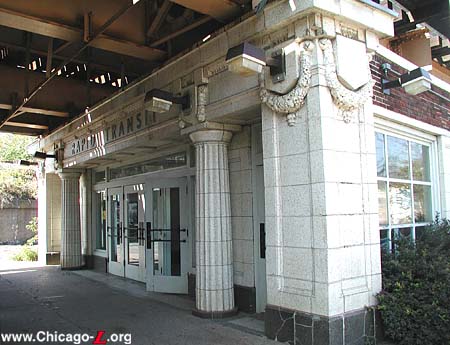
South Boulevard station,
looking west on October 20, 2002. The Beaux-Arts elements
typical of many of Arthur Gerber's rapid transit stations
are evident -- as well as the use of Doric elements in the
twin fluted columns -- but unfortunately the original lights
have been replaced. For a larger view, click
here.
(Photo by Tony
Coppoletta)
|
South Boulevard
(525N/500W)
South Boulevard and
Chicago Avenue, City of Evanston
Service
Notes:

|
Purple Line:
Evanston
|
Quick Facts:
Address: 602 South
Boulevard
Established: July 1, 1931
Original Line: North Side Division, Evanston branch
Previous Names: none
Skip-Stop Type: All-Stop
Rebuilt: n/a
Status: In Use
History:
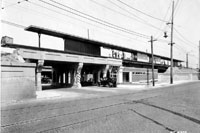
The station house with terra cotta entryway and island platform of the new South Blvd station are seen looking northwest on opening day, July 1, 1931. For a larger view, click here. (Photo from the CTA Collection) |
The station at South Boulevard was built in 1930-31, replacing the
Calvary Cemetery station one block south.
Opened on July 1, 1931, this site was far better suited to serve the
increasing population in the new apartments north of the cemetery. As
a result of the move, ridership doubled Calvary's
boardings during the period 1932-1946.
The facade and interior, which was very
similar to the Central station farther north on the Evanston line and Sheridan on the Howard branch, was typical of a series of designs executed by Gerber during this period. The front elevation combines elements of Doric and Beaux-Arts designs, executed in off-white terra cotta. Trademark Gerber details include the laurel-framed cartouches, a pair of Greek Revival Doric columns framing the entrance, gloved lights and the words "Rapid Transit" above the door in terra cotta.
The interior was executed in smooth stone
with a spacious fare control area, with terrazzo flooring and "art
marble" and plaster walls. The interior
footprint was large
enough for a newsstand or other retail space, but was never partitioned off for use in that
capacity. The sole element punctuating the floor space was a decorative Prairie School-influenced wooden ticket agent's booth in the middle of the interior and a few railings for fare control (though no turnstiles, originally).
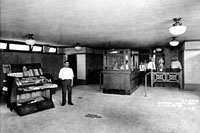
The interior of the South Blvd station is seen as it was originally built on July 1, 1931, its first day of service. For a larger view, click here. (Photo from the CTA Collection) |
The platform is of the island variety between the middle two
tracks. The platform had wood decking and a canopy with metal columns
down the center line which split into gently-curving gull wing-shaped
roof supports, supporting a wooden canopy roof. The stairs are
sheltered by wooden enclosures with swinging doors at the front of
each enclosure. The platform, which was later replaced with a
concrete deck, is unusually narrow.
Over the years, South Blvd. station's architecture has remained
largely historically intact, with its original facade, interior terrazzo floors, wood
moldings and decorative agent's booth, and original canopy structure all intact. Other features, however, such
as the original exterior globed lights (removed in early 1998), have
been lost.
During early April 2004, South Boulevard received new platform
signage. The older KDR-type
station name signs were replaced with new Green Line
Graphic Standard versions. The thinner strap brackets that held
up the previous signs were replaced with more substantial steel
frames. Also replaced were the directional wayfinding signs, the
long signs directing passengers to which direction of service
operates on which side of the platform, at the top of each stair to
the platform. Column-mounted "symbol signs" were installed in May.
Interestingly, this represented the first time that Green Line
Graphic Standard signage was applied to a Purple Line station
(discounting shared facilities at Chicago and in the Loop). In June 2005, new station entrance signs were added
at street level, hung over the sidewalk from the concrete
viaduct.
Historically, the Evanston branch used overhead wire for traction power, dating from when service began in 1908 as a ground-level operation, but remaining in use even after the tracks were elevated and into the CTA era. The overhead originally extended all the way to Howard, but in 1963 the wire was replaced with third rail between South Blvd. and Howard, making South Blvd. the location where trains switched between trolley poles and third rail shoes for power. By this time, "L" trains' crews had been reduced to two persons (with only a few exceptions), with the conductor responsible for raising or lowering the poles. However, rush period Evanston Express trains at the time were typically four cars long, which would have been a time-consuming (and delay-inducing) job for one person, even though only every other car's poles had to be raised (the 4000-series cars used at the time were semi-permanently paired, with jumpers between the car's traction power systems). So during rush periods, a platform person was assigned to South Blvd. to help raise and lower poles -- typically, the platform person handled the pole on the first car while the conductor handled the pole on the third car. This continued until use of overhead wire for power was discontinued on the Evanston branch in 1973.
A spur track -- sometimes called
the "team track" -- diverges from the northbound track in the middle
of the station and continues a short distance to the north. Generally-speaking, a team track is a small siding or spur track intended for the use of area merchants, manufacturers, and other small businesses to personally load and unload products and merchandise, usually in smaller quantities. Commercial use of the team track declined rapidly through the 1960s, however. More recently, it was used sporadically, typically for delivery of materials such as ballast to CTA or to load work equipment for specific projects. The South Blvd. team track was removed from service effective Friday, April 1, 2016, though it remains in place for potential use, if required.
Red-Purple Lines Modernization (RPM) Project
Due to the deteriorating condition of the infrastructure on the Red Line north of Belmont and on the Purple Line, the CTA initiated the Red-Purple Modernization Project (RPM) to bring the existing transit stations, track systems, and structures into a state of good repair. The project, which stretches along the existing Red and Purple lines from north of Belmont station to Linden terminal, would help bring the existing transit line into a state of good repair, reduce travel times, improve access to job markets and destinations, and provide improved access to people with disabilities.
The project began in 2009 with a vision study to assess the scope of needs and develop a set of alternatives for study. In 2010, in accordance with the National Environmental Policy Act (NEPA), CTA and Federal Transit Administration (FTA) initiated the environmental review process for the project and undertook work to develop an Environmental Impact Statement (EIS). The process included numerous public meetings and input opportunities, and study of various alternatives for achieving a good state of repair for the infrastructure in the project area.
A number of alternatives were considered for the RPM project, including the comprehensive reconstruction of track, stations, and structures along the line. The four options that were considered and studied, not including an FTA-required "no action" baseline scenario, included:
- Basic Rehabilitation: provided a strategic mix of repairs, rehabilitation, and replacement of the existing infrastructure for a useful life of 20 years, plus the addition of a transfer station at Loyola; all station locations remained the same.
- Modernization with Station Consolidation: provided a brand new elevated structure between Lawrence and Howard, modern amenities at stations, increases speed of service, included new transfer station at Loyola, and major reconstruction and renovation to extend the useful life to 60-80 years; several stations would be consolidated by closing one station and adding a second entrance at an adjacent station.
- Modernization without Station Consolidation: provided a brand new elevated structure between Lawrence and Howard, modern amenities at stations, modest increase in speed of service, included new transfer station at Loyola, and major reconstruction and renovation to extend the useful life to 60-80 years; all station locations remained the same.
The Modernization with Station Consolidation option included the consolidation of South Blvd. and Main stations by closing the existing South Blvd. station and adding a new entrance to Main at Madison Avenue, approximately two blocks north of South Blvd. station.
However, the Modernization without Station Consolidation concept was advanced as the locally preferred alternative (LPA), and it is not currently envisioned that South Blvd. would close or be consolidated when this section of the Evanston branch is renovated under RPM. The RPM project is being undertaken in phases, and construction for Phase One, which concentrates on sections of the Red Line, officially began in 2019. There is presently no official timeframe for when a future phase that would cover the Evanston branch will commence.
See CTA's Red & Purple Modernization page for more information about the scoping and planning process.
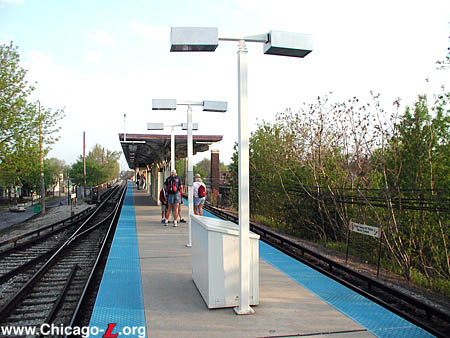
The island platform at South
Boulevard, looking south from the north end on May 8, 2004.
The canopy edge has been painted purple to denote its
location on the line of the same name. For a larger view,
click here.
(Photo by Graham
Garfield)
|

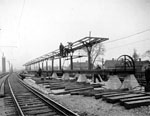 |
southblvd07.jpg (173k)
Crews work to erect the steel framework of the South Blvd. platform and canopy, looking south in 1931. Note that the active tracks are temporarily on a runaround, or "shoe-fly", around the station construction site. (Photo from the CTA Collection) |
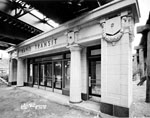 |
southblvd08.jpg (193k)
The South Blvd. station house, and its ornamental Beaux-Arts terra cotta front facade, are nearing completion in this view looking north on May 29, 1931, a month before the station would open. The masonry and stone work is all in place, and the storefront including polished brass door handles and kick plates have been installed; only the light fixtures and a few other minor finishes remain. Note the wooden trestle on the far right, carrying trains temporarily around the construction site.
(Photo from the CTA Collection) |
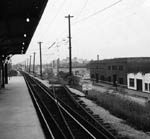 |
ROW@SouthBlvdTeamTrk01.jpg (79k)
This view looking north from the South Blvd. platform on September 10, 1963 shows the South Boulevard team track branching off from the main line. The team track was a rail siding for general usage by freight shippers where freight cars could be spotted and loaded or unloaded by an industry or shipper. The small sign to the right of the switch reads, "RAISE TROLLEY POLES HERE". About two months earlier, on July 6, 1963, trolley wire was replaced with third rail on the Evanston Line between Howard and South Blvd. However, the line north of South Blvd. to Isabella and the team track still used overhead trolley wire to power trains, requiring trolley poles on the cars to the raised and lowered here. (CTA Photo, Graham Garfield Collection) |
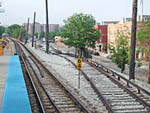 |
ROW@SouthBlvdTeamTrk02.jpg (289k)
The South Boulevard team track is seen looking north from the South Blvd. station platform on July 12, 2005. Although the team track is not regularly used anymore, it is kept in service and see occasional use for loading rail-borne equipment or delivery of materials. (Photo by Graham Garfield) |
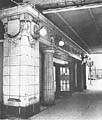
|
southblvd01.jpg
(32k)
South Boulevard station, looking east in 1985. The
Beaux-Arts elements typical of many of Arthur Gerber's rapid
transit stations are evident. The original light fixtures
are still intact in this view.
(Photo by Olga Stefanos) |
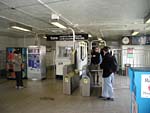
|
southblvd04.jpg
(143k)
The interior of South Boulevard station, seen here
looking north in the unpaid area on October 20, 2002, is
quite spacious. There is more than enough room for either a
waiting room space or a concessionaire, but it has never
regularly been used as the former and the latter has never
been anything more substantial than a newsstand or
shoeshine. Still, it is very well-intact historically, with
its original agent's booth, terrazzo floors, and wall
moldings.
(Photo by Tony Coppoletta) |
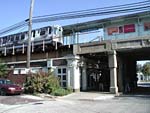
|
southblvd05.jpg
(182k)
This view looking east on South Boulevard on October 20,
2002 shows a good side profile of the station, including the
molded concrete viaduct in front, the brick and glass
paneled sides of the headhouse, and the platform above. The
Illinois Dept. of Public Health's anti-smoking ad wrap cars
are above on a charter for the 2002
Historic "L" Station Tour.
(Photo by Tony Coppoletta) |
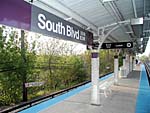
|
southblvd06.jpg
(214k)
New station name signs and directional signs were
installed at South Blvd. station in April 2004, as seen
looking north on May 8, 2004 just north of the north stairs
from the station house. New symbol signs followed in May. (Photo by Graham Garfield) |
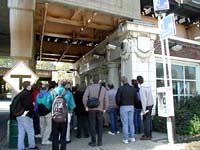
|
tour02@SouthBlvd01.jpg
(172k)
The tour group is assembled in front of South Blvd.
station to view the ornate facade as the guides share
information about the facility during the 4th
Annual Historic "L" Station Tour on October 20,
2002. (Photo by Tony Coppoletta) |
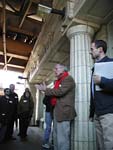
|
tour02@SouthBlvd02.jpg
(145k)
The fluted Doric pillar of Beaux-Arts South Blvd. station
provides the backdrop of Guide John Craib-Cox's discussion
of the station's architectural design and building materials
as tour members attentively listen during the 4th
Annual Historic "L" Station Tour on October 20,
2002. (Photo by Tony Coppoletta) |
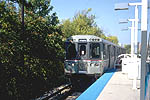
|
cta2860.jpg
(122k)
A four-car Purple Line Shuttle led by car 2860 pulls into
South Blvd. on it's way to Howard
on September 26, 1999. (Photo by Mike
Farrell) |
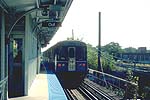
|
cta2858c.jpg
(103k)
Pulling south out of South Boulevard. heading to Howard to complete its run, car
2858 is at the rear of a Purple Line Shuttle train on
September 26, 1999. (Photo by Mike
Farrell) |

- PurpleRun542.wav
(294k): "Welcome aboard Purple Line Run 542. South Boulevard is
next. In the direction of travel, doors open on the left at South
Boulevard." (Sound
courtesy of Tony Coppoletta)
.
- SouthBlvd_next.wav
(130k): "South Boulevard is next. Doors open on the left at South
Boulevard." (Sound
courtesy of Tony Coppoletta)


















